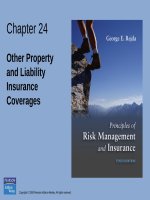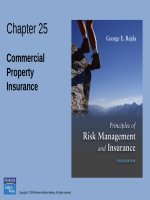Principles of risk management and insurance 12th by rejde mcnamara chapter 25
Bạn đang xem bản rút gọn của tài liệu. Xem và tải ngay bản đầy đủ của tài liệu tại đây (366.37 KB, 32 trang )
Chapter 25
Commercial
Property
Insurance
Agenda
•
•
•
•
•
•
•
•
Commercial Package Policy
Building and Personal Property Coverage Form
Causes-of-Loss Forms
Reporting Forms
Business Income Insurance
Other Commercial Property Coverages
Transportation Insurance
Businessowners Policy
Copyright ©2014 Pearson Education, Inc. All rights reserved.
25-2
Commercial Package Policy
• Business firms can purchase a commercial
package policy (CPP)
– A package policy is one that combines two or
more coverages into a single policy
– A multiple-line policy combines coverages for
property and liability into a single policy
– A monoline policy contains only one type of
coverage
– Advantages include: fewer gaps in coverage,
lower premiums, and convenience
– The CPP is tailored to cover most property and
liability loss exposures
Copyright ©2014 Pearson Education, Inc. All rights reserved.
25-3
Exhibit 25.1 Components of a Sample Commercial
Package Policy (CPP) (Endorsements omitted)
Copyright ©2014 Pearson Education, Inc. All rights reserved.
25-4
Building and Personal Property
Coverage Form
• The building and personal property (BPP)
coverage form is a commercial property
coverage part that is widely used to cover a
direct physical damage loss to commercial
buildings and personal property
– The form covers the buildings described in the
declarations, including fixtures and permanently
installed machinery and equipment
– Business personal property, such as furniture
and computers, is covered
Copyright ©2014 Pearson Education, Inc. All rights reserved.
25-5
Building and Personal Property
Coverage Form
– Coverage includes the insured’s interest in
improvements and betterments as a tenant
– Personal property of others in the care, custody,
or control of the named insured is also covered
– Additional coverages include debris removal, the
cost of preserving property, fire department
charges, and the cost to replace data destroyed
by a covered loss
– Under certain conditions, the insurance can be
extended to cover other property, such as the
personal effects of employees, newly acquired
property, and property off the premises
Copyright ©2014 Pearson Education, Inc. All rights reserved.
25-6
Building and Personal Property
Coverage Form
– A standard deductible of $500 applies to each
occurrence
– If applicable, the coinsurance requirement must
be met to avoid a penalty
– The policy can be endorsed to cover losses on an
agreed value or replacement cost basis, to add
an inflation guard, or to extend replacement cost
to the personal property of others
Copyright ©2014 Pearson Education, Inc. All rights reserved.
25-7
Causes-of-Loss Forms
• A causes-of-loss form must be added to
the policy to have a complete contract
– The form specifies the covered perils for the
business and personal property coverage
• The causes-of-loss basic form provides
coverage for 11 basic causes of loss:
–
–
–
–
–
–
Fire
Lightning
Explosion
Windstorm or hail
Smoke
Aircraft or vehicles
Copyright ©2014 Pearson Education, Inc. All rights reserved.
–
–
–
–
–
Vandalism
Riot or civil commotion
Sprinkler leakage
Sinkhole collapse
Volcanic action
25-8
Causes-of-Loss Forms
• The causes-of-loss broad form includes all
causes of loss covered by the basic form
plus:
–
–
–
–
Falling objects
Weight of snow, ice, or sleet
Water damage
Also, collapse is covered for certain causes, such
as hidden decay
• The causes-of-loss special form insures
against “risks of direct physical loss” unless
specifically excluded
Copyright ©2014 Pearson Education, Inc. All rights reserved.
25-9
Reporting Forms
• A reporting form requires the insured to report
periodically the value of insured business
personal property
– The value reporting form is used to insure
fluctuations in business personal property
– Premiums are based on the actual value of the
covered property
– If the insured underreports the property values at a
location, and a loss occurs at that location, recovery
is limited to the proportion that the last value
reported bears to the correct value that should have
been reported
– A peak season endorsement increases the amount
of insurance in force during a specified period to
reflect higher inventory values
Copyright ©2014 Pearson Education, Inc. All rights reserved.
25-10
Business Income Insurance
• Business income insurance is designed to
cover the loss of business income, expenses
that continue during the shutdown period,
and extra expenses because of loss from a
covered peril
• The business income (and extra expense)
form covers the loss of business income due
to suspension of operations
– Business income is defined as the net profit or
loss before income taxes that would have been
earned, and continuing normal operating
expenses, including payroll
Copyright ©2014 Pearson Education, Inc. All rights reserved.
25-11
Business Income Insurance
• The business income coverage form can be
purchased with coinsurance of 50, 60, 70,
80, 90, 100, or 125%
– The coinsurance percentage selected depends
on the length of time it takes to complete repairs
and resume operations
– A higher percentage should be selected if the
business expects to be shut down for a longer
period of time
Copyright ©2014 Pearson Education, Inc. All rights reserved.
25-12
Business Income Insurance
• The business income form provides several
additional coverages, including:
– Loss of business income and extra expenses
caused by action of civil authority
– Loss of business income and extra expenses as a
result of direct physical damage loss to a new
building, or because of alterations or additions to
existing buildings
– An extended business income provision covers
the reduction in earnings for a limited period
after the business reopens
Copyright ©2014 Pearson Education, Inc. All rights reserved.
25-13
Business Income Insurance
• The business income form provides several
optional coverages, including:
– A maximum period of indemnity of 120 days
– A monthly limit of indemnity that eliminates the
coinsurance requirement and limits the maximum
monthly amount that will be paid for each
consecutive 30-day period
– Business income agreed value, which suspends the
coinsurance clause and places no limit on the monthly
amount paid, provided that the agreed amount of
insurance is carried
– An extended period of indemnity, allowing for a
longer period for completion of repairs
Copyright ©2014 Pearson Education, Inc. All rights reserved.
25-14
Business Income Insurance
• The extra expense coverage form is a
separate form that can be used to cover the
extra expenses incurred by the firm in
continuing operations during a period of
restoration
– Can be used by firms that must continue to
operate after a loss occurs, such as a newspaper
– The form does not cover loss of business income
– Expenses to continue operations are covered,
subject to certain limits
Copyright ©2014 Pearson Education, Inc. All rights reserved.
25-15
Business Income Insurance
• An endorsement can be added to cover the
loss of business income from dependent
properties
– Used when a business depends on a single
supplier for raw materials, or relies on a single
customer to purchase its products
– The loss of income must result from direct
damage to property of the dependent property
• Types of dependent properties include:
–
–
–
–
Contributing location
Recipient location
Manufacturing location
Leader location
Copyright ©2014 Pearson Education, Inc. All rights reserved.
25-16
Other Commercial Property
Coverages
• Some firms have certain needs that require
more specialized property coverage
• The builders risk coverage form can be used
to insure buildings under construction
– Covers the insurable interest of a general
contractor, subcontractor, or building owner
– Insurance is purchased equal to the full value of
the completed building
– A builders risk reporting form can be attached as
an endorsement
Copyright ©2014 Pearson Education, Inc. All rights reserved.
25-17
Other Commercial Property
Coverages
• A condominium association coverage form covers
commercial and residential condominiums
– Coverage includes the association’s personal property,
such as exercise room equipment
– Coverage also includes personal property in the
association’s care, such as leased lawn mowers
• Businesses that own units in a condominium
building can purchase a condominium commercial
unit-owners coverage form
– Not used for residential condominium units
– The form covers the business property of the unit owner,
such as furniture, fixtures and improvements, machinery
and equipment
Copyright ©2014 Pearson Education, Inc. All rights reserved.
25-18
Other Commercial Property
Coverages
• Equipment breakdown insurance covers
losses due to the accidental breakdown of
covered equipment, such as steam boilers,
refrigeration equipment, and computer
equipment
– These losses are not covered under the causesof-loss forms
– A breakdown is a direct physical loss that causes
damage to covered equipment
– Covered equipment includes the boiler,
machinery, electrical, mechanical,
communication and computer equipment
insured under the policy
Copyright ©2014 Pearson Education, Inc. All rights reserved.
25-19
Other Commercial Property
Coverages
• The current ISO form for equipment
breakdown insurance may include, for
example:
– Property damage
– Expediting expenses
– Business income and extra expense-extra expense
only
– Spoilage damage
– Utility interruption
– Errors and omissions
– Brands and labels
Copyright ©2014 Pearson Education, Inc. All rights reserved.
25-20
Other Commercial Property
Coverages
• Difference in Conditions (DIC) insurance is
an “all-risks” policy that covers other perils
not insured by basic property insurance
contracts
– The coverage fills gaps in commercial property
coverage
– The coverage can be used to insure unusual and
catastrophic exposures that are not covered by
the underlying contracts
– A substantial deductible must be satisfied for
losses not covered by the underlying contracts
– Many multinational corporations use a DIC policy
to insurer their overseas property
Copyright ©2014 Pearson Education, Inc. All rights reserved.
25-21
Transportation Insurance
• Ocean marine insurance provides protection
for goods transported over water
• Ocean marine insurance comes in several
different forms:
– Hull insurance covers physical damage to the
ship or vessel
– A collision liability clause (running down clause)
covers the owner’s legal liability if the ship
collides with another vessel or damages its cargo
– Cargo insurance covers the shipper of the goods
if the goods are damaged or lost
– Regular shipments can be covered with an opencargo policy
Copyright ©2014 Pearson Education, Inc. All rights reserved.
25-22
Transportation Insurance
– Protection and indemnity (P&I) insurance is
usually written as a separate contract that
provides comprehensive liability insurance for
property damage or bodily injury to third parties
– Freight insurance indemnifies the ship owner for
the loss of earnings if the goods are damaged or
lost and are not delivered
Copyright ©2014 Pearson Education, Inc. All rights reserved.
25-23
Transportation Insurance
• Ocean marine insurance is based on certain
fundamental concepts, or implied warranties:
– The owner implicitly warrants that the vessel is
seaworthy
– The ship can only deviate from its original course
to avoid an accident, or to save the life of an
individual on board, or rescue persons from
another vessel
– The purpose of the voyage is legal
• The ocean marine policy provides broad
coverage for perils of the sea, such as bad
weather, high waves, collision, sinking, and
stranding
Copyright ©2014 Pearson Education, Inc. All rights reserved.
25-24
Transportation Insurance
• A particular average is a loss that falls entirely on a
particular interest
– Under the free-of-particular average (FPA) clause, partial
losses are not covered unless the loss is caused by certain
perils, such as stranding or sinking
• A general average is a loss that falls on all parties
to the voyage, incurred for the common good
– Each party must pay its share of the loss based on the
proportion that its interest bears to the total value in the
venture
– Conditions for a general average loss include imminent
peril, voluntary sacrifice, preservation of at least part of
the value
Copyright ©2014 Pearson Education, Inc. All rights reserved.
25-25









